 I’m beginning to think there is a horse race between the rising price of firearms and the rising price of optics, with optics winning at the moment by more than a nose. A quick check of discount retail pricing suggests Leupold’s move from the Vari-X III to VX-III resulted in a 25%+ price bump. While the VX series incorporates current trend product refinements to accompany the price increase, these new features may not be germane to most applications.
I’m beginning to think there is a horse race between the rising price of firearms and the rising price of optics, with optics winning at the moment by more than a nose. A quick check of discount retail pricing suggests Leupold’s move from the Vari-X III to VX-III resulted in a 25%+ price bump. While the VX series incorporates current trend product refinements to accompany the price increase, these new features may not be germane to most applications.The .17 HMR brought with it comparatively low cost firearms that possess a good deal of moderately long range potential. These guns can obviously benefit from high performance / high magnification optics, but beg the question, “Is it proper optical etiquette to put a $1,000 scope on a $300 rifle?”. The answer is, “Probably not”. I do believe I am now asking and answering my own questions…which can’t be all good. I think I just did it again. Anyway, I think you get my drift. If these great little rifles make for inexpensive recreational target shooting, why spoil the fun with a requirement for an expensive scope? With these thoughts in mind, and a wife irritated with me because I kept borrowing the scope from our Marlin 17VS for service on other rifles, I started looking for another scope.
BSA. Weren’t those things hard to start ?
Over the years, Birmingham Small Arms (BSA) has produced everything from Motorcycles to firearms. In fact, the only reason my wife of many years initially agreed to go on a date with me was because I was riding a: hard starting, engine thumping, oil spewing, front wheel wobbling, chain tossing, 650cc twin BSA Spitfire. At least that’s my take on the situation. Her story is I looked so pathetic on that broken down bike she dated me as an act of charity – Six of one, half dozen of the other. Today, BSA Optics of Fort Lauderdale, FL produces lines of rifle and handgun scopes, red dot systems, spotting scopes, and binoculars. There are nine series of scopes, each dedicated to a specific application; hunting, target, handgun, etc. Each series provides a set of features and specs appropriate to their purpose. The Platinum series is dedicated to high magnification target scopes.
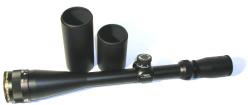 The BSA Platinum 8-32 x 44mm scope with a Mil Dot Reticle carries an MSRP of $229, but it is available through most discount retailers for under $110. By comparison, a Burris rim fire / air gun scope of the same magnification sells in the $450 ~ $470 range through the same channels. The implication of such a great price differential is that the BSA product would somehow be inferior to the Burris product; but perhaps not.
The BSA Platinum 8-32 x 44mm scope with a Mil Dot Reticle carries an MSRP of $229, but it is available through most discount retailers for under $110. By comparison, a Burris rim fire / air gun scope of the same magnification sells in the $450 ~ $470 range through the same channels. The implication of such a great price differential is that the BSA product would somehow be inferior to the Burris product; but perhaps not.
| Feature | BSA | Burris |
| Field of View Low-High | 11-3.5′ | 14-4.5′ |
| Click Value | 1/8 MOA | 1/6 MOA* |
| Adjustment Range | 22″ | 22″ |
| Weight-Ounces | 19.5 | 24 |
| Eye Relief | 3.0 | 3-3.5 |
| Objective Bell Diameter | 55mm | 60mm |
| Objective Lens Diameter | 44mm | 44mm |
| Ocular Diameter | 39mm | 39mm |
| Exit Pupil | 5.5-1.4 | 5.1-1.4mm |
| Overall Length | 16″ | 17.2″ |
| Water, fog and shockproof | Yes | Yes |
| Warranty | Lifetime | Lifetime |
| *RF / Airgun version 1/8 for centerfire models | ||
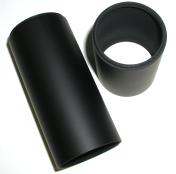
 A comparison of published specifications seems to favor the BSA scope; the same performance in a smaller mechanical envelope. In addition, the BSA scope has some enhancements I wouldn’t mind seeing on significantly more expensive scopes.
A comparison of published specifications seems to favor the BSA scope; the same performance in a smaller mechanical envelope. In addition, the BSA scope has some enhancements I wouldn’t mind seeing on significantly more expensive scopes.The BSA scope is supplied with two sun shades, 3″ and 5″. These are quality aluminum pieces, well coated in flat black with a rib baffled interior. The scope package also includes machined aluminum threaded optical caps – a very nice touch.

The BSA Platinum scope has target type windage and elevation turret knobs. No tools needed to adjust and, once zeroed, the three set screws securing each knob can be loosened to set the adjustment index scale to “0”. There are tactile feel click increments of 1/8 MOA.
Things like this may not seem like much, but consider the fact that Stoney Point aftermarket target turret knobs sell for about $50 per set, or almost half the price of the entire BSA scope. The adjustment tactile feel is distinct and uniform. I set up the scope with a collimator; vertical was on as installed and windage was off two clicks left. The scope was basically mid range in mechanical adjustment as installed and 22″ of adjustment is a lot of latitude for a scope with this level of magnification.
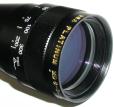
The focus ring around the objective bell is indexed for 25, 50, 75, 100, 200, 300 yards, and infinity. The adjustment is smooth and it stays set, the numbers are large and easy to read. The purpose of this feature is parallax correction which requires the scope to be in focus at the range of the target. When this is not the case, a scope’s reticle may appear to shift against a stationary target while the shooter’s is lining up through the scope.
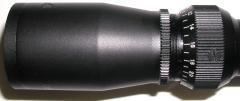
The eyepiece is straight forward; adjustable for reticle focus and the magnification zoom ring located just forward is smooth in use. One thing I noticed when looking through the scope is that the diameter of the image seemed smaller than some other scopes with the same tube diameter and similar magnification. After looking through several, and taking some further outside diameter measurements of eyepieces, I arrived at the conclusion the BSA scope has a large eyepiece, but the actual ocular lens is about standard for most scopes. The lens is about 32mm, or 7mm less than the eyepiece, causing the image to appear slightly undersize.
I know, it seems like it would be short for MILitary.

The particular version of the scope I purchased has a Mil-Dot reticle. “Mil” in this case, is short for “milliradian”, a relative unit of measurement. I will not do the math, you can search the Internet and you will find many multiple page articles explaining how to calculate the space between dots at various distances. They will also all conclude by indicating 1 milliradian at 1000 yards is equal to 36″. At 100 yards 1 milliradian is 3.6″. So each additional hundred yards increases the space represented between two dots by another 3.6″.
The logic brought to the forefront is that knowing the approximate size of the target will permit range estimating with a mil dot scope. If there is a 3.6″ circle out there and it fits between 2 vertical mil dots on the reticle, it is 100 yards away. If a Moose’s 10.8″ nostril fits between two dots, it is 300 yards away. If a mature deer’s chest fits between two dots it is approximately 1,000 yards off, as long as it is wearing a 36 regular. I have had range finder scopes dating back to an old Tasco elevation distance indexed turret knob yet, for some strange reason, I still prefer guessing incorrectly rather than use these simple tools. The deer apparently applaud my position, still, guessing at the size of an animal, to avoid guessing a distance, or buying a range finder, doesn’t seem much like progress. Why did I buy the Mil-Dot model ? I saved $15. One closing note on this issue, the Mil-Dot spacing of 3.6″ is typically a maximum magnification. In the case of this scope the reference is correct at 10x.
Conclusion
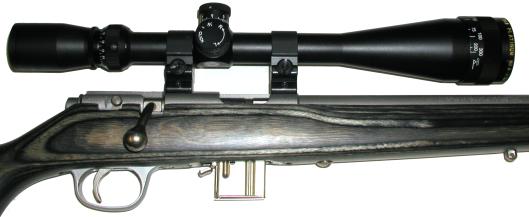
The scope does not detract from the overall appearance of the Marlin, it fits well with the heavy barrel and the height feels comfortable for easy eye alignment. The space between the objective bell and barrel leaves a little room for objective focus adjustment. Best news, it works really well. Shot placement didn’t shift with magnification, the view through the scope was very bright, particularly for such high magnification and the adjustment knobs don’t require visual feedback for setting. Are there areas that can be improved? Sure. The current trend in lower priced scopes is for a finishing process that leaves a near semi-gloss rather than a true matte finish. The short eye relief, combined with the limited dovetail mount position of the Marlin, put the rear ring up against the scope adjustment turret boss causing me to crane my head and neck forward to achieve a proper distance from the scope when shooting from the bench. All and all, a very good scope.
Thanks
Joe

Email Notification